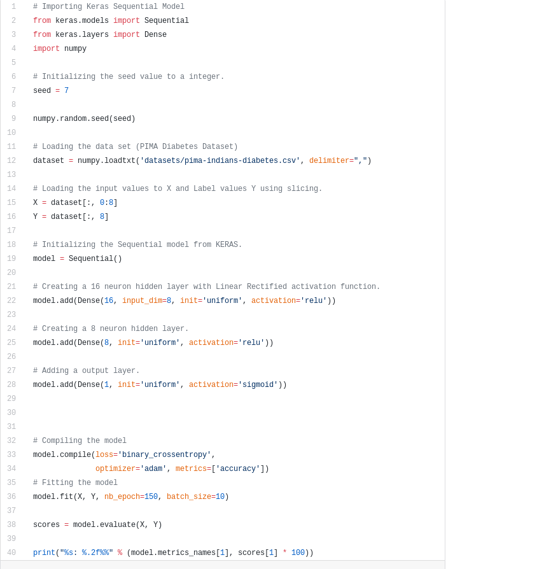Python
Python is one of the most popular programming languages for artificial intelligence (AI) due to its simplicity, flexibility, and the availability of numerous powerful libraries and frameworks. Here are some key aspects of Python that make it well-suited for AI:
1. Readability and Simplicity: Python has a clean and readable syntax, which makes it easy to understand and write code. This simplicity is beneficial when working on complex AI algorithms and models, as it allows developers to focus more on the logic and concepts rather than getting caught up in intricate syntax details.
2. Extensive Libraries and Frameworks: Python offers a rich ecosystem of libraries and frameworks that are specifically designed for AI and machine learning tasks. Some widely used libraries include:
- NumPy: A fundamental library for numerical computations and efficient handling of multi-dimensional arrays.
- pandas: A powerful data manipulation and analysis library that simplifies data preprocessing and exploration.
- scikit-learn: A comprehensive machine learning library that provides a wide range of algorithms and tools for tasks like classification, regression, clustering, and model evaluation.
- TensorFlow and PyTorch: Deep learning frameworks that enable the creation and training of neural networks for tasks like image recognition, natural language processing, and more.
- Keras: A high-level neural network library that runs on top of TensorFlow or other backends, offering a user-friendly interface for building and training neural networks.
These libraries provide efficient implementations of AI algorithms, making it easier to develop AI models and systems.
3. Community and Support: Python has a large and active community of developers, researchers, and enthusiasts working in the field of AI. This vibrant community contributes to the development of various AI-related libraries, frameworks, and tools, and provides support through forums, online resources, and code repositories like GitHub. The availability of community support makes it easier for beginners to learn and get help when facing challenges.
4. Integration and Interoperability: Python can be seamlessly integrated with other languages, allowing you to leverage existing AI libraries and tools written in different languages. For example, Python can be used to interface with C/C++ libraries, which are often used for performance-critical tasks in AI. This interoperability enables you to combine the strengths of multiple languages and utilize a broader range of resources.
5. Data Science Ecosystem: Python has become the go-to language for data science, and AI often relies heavily on data analysis and manipulation. Python's data science ecosystem, consisting of libraries like NumPy, pandas, and matplotlib, provides powerful tools for data preprocessing, visualization, and analysis. This integration of AI and data science capabilities makes Python a versatile choice for AI projects.
Overall, Python's simplicity, extensive libraries, strong community support, and integration capabilities make it an excellent programming language for AI. Its popularity in the AI community ensures that you'll find numerous resources, tutorials, and code examples to facilitate your AI development journey using Python.
Deep Learning with Python
The human brain imitation.
The main reason behind deep learning is the idea that, artificial intelligence should draw inspiration from the brain. This perspective gave rise to the “Neural Network” terminology. The brain contains billions of neurons with tens of thousands of connections between them. Deep learning algorithms resemble the brain in many conditions, as both the brain and deep learning models involve a vast number of computation units (Neurons) that are not extraordinarily intelligent in isolation but become intelligent when they interact with each other.
I think people need to understand that deep learning is making a lot of things, behind-the-scenes, much better. Deep learning is already working in Google search, and in image search; it allows you to image search a term like “hug.”— Geoffrey Hinton
Neurons
The basic building block for neural networks are artificial neurons, which imitate human brain neurons. These are simple, powerful computational units that have weighted input signals and produce an output signal using an activation function. These neurons are spread across the several layers in the neural network.

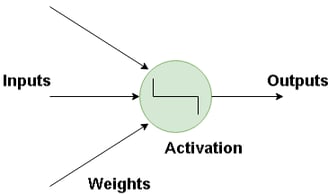
How Does Artificial Neural Network Works?
Deep learning consists of artificial neural networks that are modelled on similar networks present in the human brain. As data travels through this artificial mesh, each layer processes an aspect of the data, filters outliers, spots familiar entities, and produces the final output.
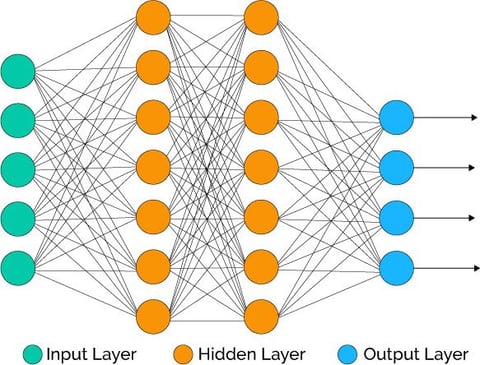

Input layer :
This layer consists of the neurons that do nothing than receiving the inputs and pass it on to the other layers. The number of layers in the input layer should be equal to the attributes or features in the dataset.
Output Layer:
The output layer is the predicted feature, it basically depends in the type of model you’re building.
Hidden Layer:
In between input and output layer there will be hidden layers based on the type of model. Hidden layers contain vast number of neurons. The neurons in the hidden layer apply transformations to the inputs and before passing them. As the network is trained the weights get updated, to be more predictive.
Neuron Weights
Weights refer to the strength or amplitude of a connection between two neurons, if you are familiar with linear regression you can compare weights on inputs like coefficients we use in a regression equation.Weights are often initialized to small random values, such as values in the range 0 to 1.
Feedforward Deep Networks
Feedforward supervised neural networks were among the first and most successful learning algorithms. They are also called deep networks, multi-layer Perceptron (MLP), or simply neural networks and the vanilla architecture with a single hidden layer is illustrated. Each Neuron is associated with other neuron with some weight,
The network processes the input upward activating neurons as it goes to finally produce an output value.This is called a forward pass on the network.
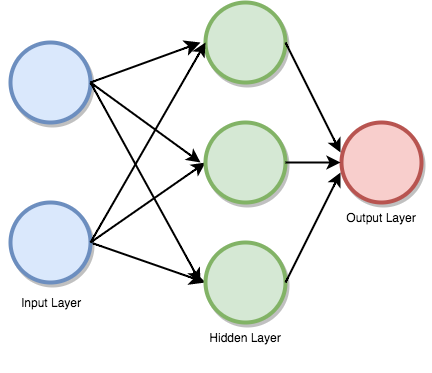

Activation Function
An activation function is a mapping of summed weighted input to the output of the neuron. It is called an activation/ transfer function because it governs the inception at which the neuron is activated and the strength of the output signal.
Mathematically,
We have many activation functions, out of which most used are relu, tanh, solfPlus.
The cheat sheet for activation functions in given below.
Back Propagation
The predicted value of the network is compared to the expected output, and an error is calculated using a function. This error is then propagated back within the whole network, one layer at a time, and the weights are updated according to the value that they contributed to the error. This clever bit of math is called the Back-Propagation algorithm. The process is repeated for all of the examples in your training data. One round of updating the network for the entire training dataset is called an epoch. A network may be trained for tens, hundreds or many thousands of epochs.
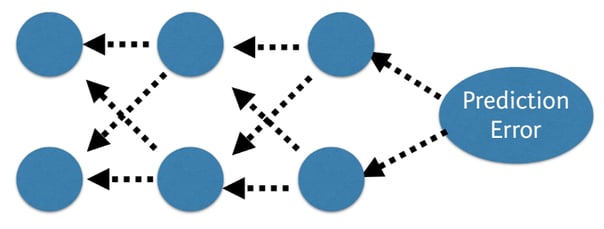

Cost Function and Gradient Descent
The cost function is the measure of “how good” a neural network did for it’s given training input and the expected output. It also may depend on attributes such as weights and biases.
A cost function is single-valued, not a vector because it rates how well the neural network performed as a whole. Using the Gradient Descent optimization algorithm, the weights are updated incrementally after each epoch.
Compatible Cost Function:
Mathematically,
Sum of squared errors (SSE)


The magnitude and direction of the weight update is computed by taking a step in the opposite direction of the cost gradient.


where Δw is a vector that contains the weight updates of each weight coefficient w, which are computed as follows:

Graphically, considering cost function with single coefficient
We calculate the gradient descent until the derivative reaches the minimum error, and each step is determined by the steepness of the slope (gradient).
Multi Layer Perceptrons (Forward Propagation)
This class of networks consists of multiple layers of neurons, usually interconnected in a feed-forward way (moving in a forward direction). Each neuron in one layer has direct connections to the neurons of the subsequent layer. In many applications, the units of these networks apply a sigmoid or relu (Rectified Linear Activation) function as an activation function.
Now consider a problem to find the number of transactions, given accounts and family members as input.
To solve this first, we need to start with creating a forward propagation neural network. Our Input layer will be the number of family members and accounts, the number hidden layers are one, and the output layer will be the number of transactions.
Given weights as shown in the figure from the input layer to hidden layer with the number of family members 2 and number of accounts 3 as inputs.
Now the values of hidden layer (i, j) and output layer (k) will be calculated using using forward propagation by the following steps.
Process
Multiply — add process.
Dot product (Inputs * Weights).
Forward propagation for one data point at a time.
Output is the prediction for that data point.
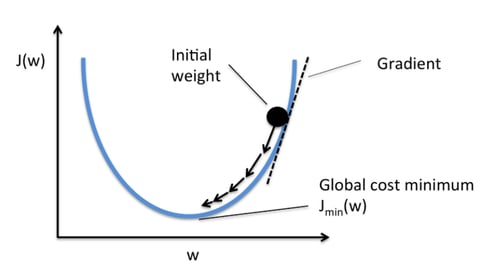



Value of i will be calculated from input value and the weights corresponding to the neuron connected.
i = (2 1) + (3 1)
→ i = 5
Similarly,
j = (2 -1) + (3 1)
→ j = 1
K = (5 2) + (1 -1)
→ k = 9


Solving the Multi Layer Perceptron problem in Python

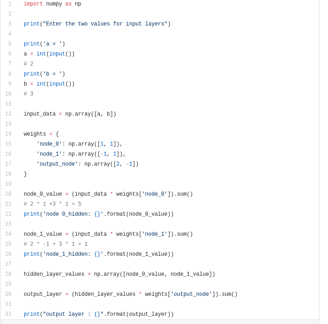
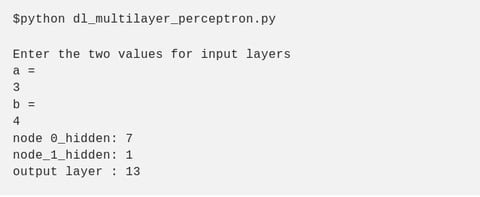

Using Activation Function
For neural Network to achieve their maximum predictive power we need to apply an activation function for the hidden layers.It is used to capture the non-linearities. We apply them to the input layers, hidden layers with some equation on the values.
Here we use Rectified Linear Activation (ReLU)
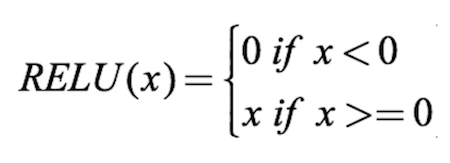

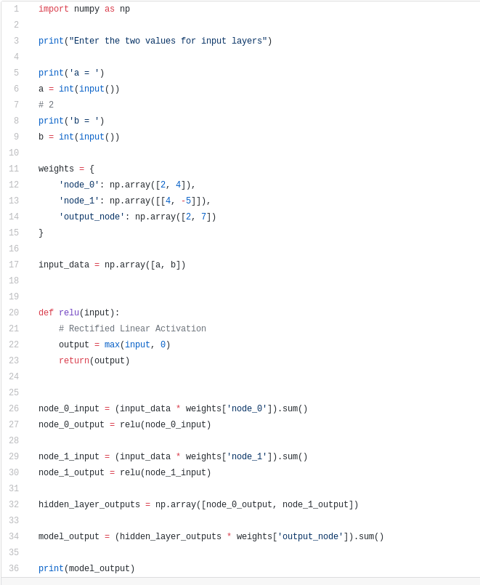

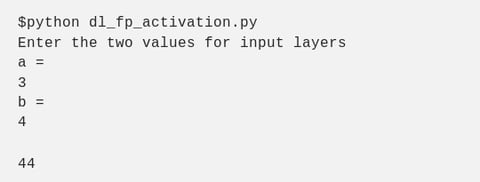

Developing First Neural Network with Keras
About Keras:
Keras is a high-level neural networks API, written in Python and capable of running on top of TensorFlow, CNTK, or Theano.
To install keras on your machine using PIP, run the following command.
Steps to implement your deep learning program in Keras
Load Data.
Define Model.
Compile Model.
Fit Model.
Evaluate Model.
Tie It All Together.
Developing your Keras Model
Fully connected layers are described using the Dense class. We can specify the number of neurons in the layer as the first argument, the initialisation method as the second argument as init and determine the activation function using the activation argument. Now that the model is defined, we can compile it. Compiling the model uses the efficient numerical libraries under the covers (the so-called backend) such as Theano or TensorFlow. So far we have defined our model and compiled it set for efficient computation. Now it is time to run the model on the PIMA data. We can train or fit our model on our data by calling the fit() function on the model.
Let’s get started with our program in KERAS,
